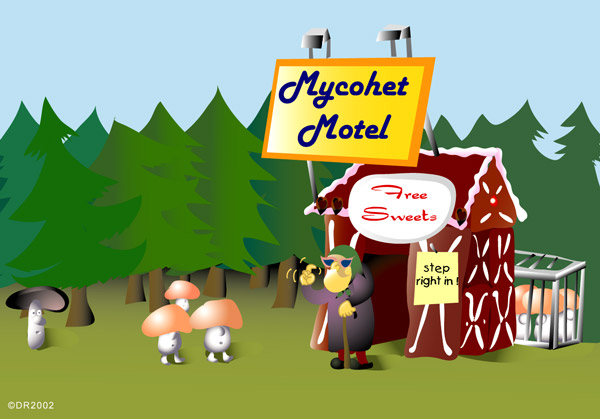
"Epiparasitic plants specialized on arbuscular mycorrhizal fungi"
Martín
I. Bidartondo (1)*, Dirk
Redecker (2)*, Isabelle
Hijri (2),
Andres
Wiemken (2) , Thomas
D. Bruns (1), Laura Domínguez (3), Alicia Sérsic
(3),
Jonathan
R. Leake (4) & David
J. Read (4)
Nature 419, 389-392 (2002)
(1) Department of Plant & Microbial Biology, University
of California, Berkeley, California 94720-3102, USA
(2) Institute of Botany, University of Basel, Hebelstrasse 1,
4056 Basel, Switzerland
(3) Instituto
Multidisciplinario de Biologia Vegetal, C.C. 495, Cordoba
5000, Argentina
(4) Department of Animal & Plant Sciences, University of
Sheffield, Sheffield S10 2TN, UK
* These authors contributed equally to this work
Background:
Plants normally obtain their carbohydrates (sugars, starch
etc.) by photosynthesis from carbon dioxide in the atmosphere
(autotrophic lifestyle). Other organisms (humans, animals,
fungi, many bacteria) need these carbohydrates because they cannot
produce them from carbon dioxide, they are heterotrophic.
It has been known for some time that certain plants abandoned
the autotrophic lifestyle and do not conduct photoynthesis anymore.
These plants do not form green photosynthetic pigments and have
become parasites on other, green plants.
Some of these non-photosynthetic plants form specialized organs
(haustoria) to directly get nutrients from their victims. However,
others do not have such obvious organs. For some of these it
has been shown that they exploit fungi who live in a symbiosis
with green plants, which is known as mycorrhiza. In a mycorrhiza
(="fungus-root"), fungi colonize the roots of and
obtains carbohydrates from the plant. In return the fungus acts
as an extended root system and provides mineral nutrients (e.g.
phosphate, nitrate, ammonium) to the plant. This relationship
is beneficial for both partners and therefore very widespread
among plants. Plants without mycorrhiza are the exception. Some
heterotrophic plants have fungi in their roots, which are connected
to nearby green plants. These plants are known as mycoheterotrophs.
They obtain their nutrients from the green plants via these fungal
bridges. By cheating the fungi they indirectly parasitize those
autotrophic plants and are called "epiparasites".
There are some rather widely known mycoheterotrophic plants,
such as some non-green orchids and plants from the family Monotropaceae.
Those plants get their nutrients from a type of mycorrhiza known
as ectomycorrhiza. This symbiosis typically occurs mainly
between trees and some groups of fungi. Some of these fungi form
fruitbodies which are visible with the bare eye ("mushrooms").
A different type of mycorrhiza, arbuscular mycorrhiza,
is much more widespread. It is found in majority of herbaceous
plants, but also in many trees in the tropics. Many important
crops are among the hosts. Exceptions are e.g. cabbage, rapeseed
and spinach. The fungal partners are less well-known fungi (Glomeromycota)
which do not form mushrooms, but spores which are visible under
the microscope.
It has been suggested that arbuscular mycorrhizal fungi may also be cheated by some non-green plants, but conclusive proof has been lacking. It has also been thought that there is a very low host specificity in arbuscular mycorrhiza, meaning that in principle every fungus can colonize every plant
What's new and exciting in this study?
The results:
- Roots of plants of three genera from two families were studied:
a) Arachnitis b) Voyria and Voyriella. They
come from two very different habitats: a) temperate forest in
Argentina, b) tropical rainforest of Guyana. The two plant families
are only very distantly related: a) Corsiaceae (lily relatives,
Monocotyledons) b) Gentianaceae (gentian family, Dicotyledons).
The fungi were identified within the roots by molecular biological analyses of characteristic genes. These genes were amplified in the test tube by a process known as Polymerase Chain Reaction and analyzed for their relationships.
- Within roots of both plant families, fungi from the group
of arbuscular mycorrhizal fungi identified in roots of Arachnitis
uniflora always contained one species of arbuscular mycorrhizal
fungi, regardless of whether the plants were from sites 70 km
apart. These fungi were also found in nearby roots of green plants
and together with some additional fungal species.
- Roots of Voyriella parviflora also contained only
one fungal species. Roots of Voyria (5 different species)
contained a more diverse set of arbuscular mycorrhizal fungi,
but mainly from one group. Voyria and Voyriella did
not share fungi even when they were occurring side by side.
What does this mean?
- Some plants are able to cheat in the arbuscular mycorrhizal
symbiosis, which is a much more widespread resource than other
mycorrhiza types. These findings suggest that in this mycorrhiza
type there can be a net carbon flow from fungus to plant. The
two-directional exchange of carbohydrates may be important but
less obvious between green plants, which are interlinked by arbuscular
mycorrhizal fungi.
- High host specificity can also be found in arbuscular mycorrhiza:
plants are extremely specialized on a small group of fungi
- Host specificity as well as carbohydrate transfer between plants have to be considered in the future as important factors shaping plant/arbuscular mycorrhizal communities. It has been shown previously that arbuscular mycorrhizal fungi can have a considerable influence on the composition of plant communities
